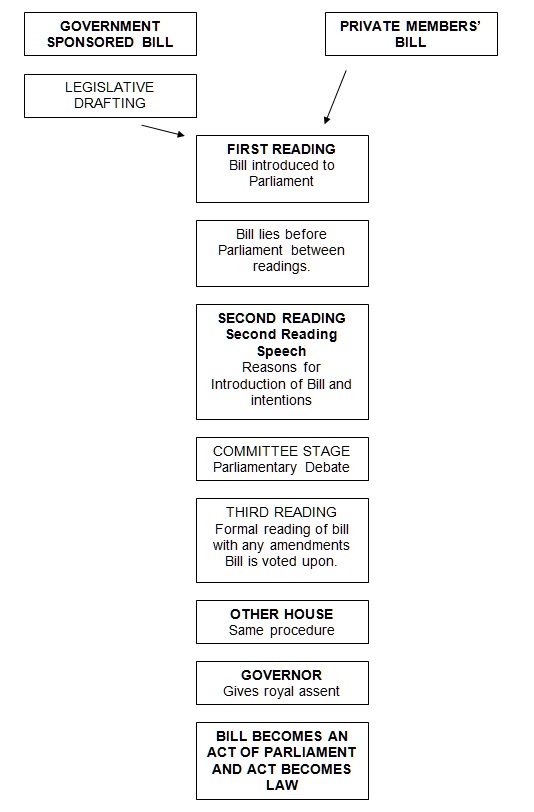What is a Bill and how does it become an Act?
An Act begins as a Bill. A Bill is a proposed law which contains amendments to legislation as suggested from the following sources:
- Government Departments (generally release draft legislation or discussion papers which form the basis of a Government Bill)
- Parliamentary Committee Reports (generally issue Committee Reports which are then tabled in Parliament)
- Community groups, lobbyist or business suggestions to change the law (generally write submissions responding to consultation papers)
- Private members' Bills (generally originates when a particular member of Parliament introduces a Bill based on personal or party beliefs)
The Bill is introduced in the house where the Minister sits (usually House of Representatives for Commonwealth and Legislative Assembly for the States but Bills can be introduced in the upper houses):
-
First Reading - Bill is introduced, made available
-
Second Reading - Bill is debated in principle and voted on, and can be disallowed - This is generally referred to as a "Failed Bill"
-
Committee Stage - Bill is examined in detail and discussed in the house clause by clause
-
Third Reading - final debate and vote
The Bills to be discussed are listed on the Parliamentary Notice Paper, where it is generally indicated whether the Bills are:
-
Government Bills - usually of general public interest and introduced by the Government, the majority of Bills are Government Bills and there are no time limits except prorogation of Parliament when dealing with Government Bills
-
Private Members' Bills - usually apply to a very specific locality or interest of the private member of Parliament, these Bills form the minority of Bills passed by Parliament and have strict time limits for when they lapse
-
Cognate Bills - are Bills of related content which should be considered simultaneously throughout their process through the upper or lower house
If the Bill is passed, it proceeds to the other house (usually the Senate for Cth and Legislative Council for the States) and undergoes the same process as the lower house.
If the:
-
Bill is passed, it is sent to the Governor-General for assent as an Act
-
Bill is passed with changes, it is sent back to other House for debate and a new vote on the changes
-
Bill is rejected, it is returned to the other House, may be resubmitted or discarded as a failed Bill
When Parliament is prorogued, as in the case of a general election being called, all Bills currently in session are dropped from the Notice Paper. At TimeBase, we refer to this as the Bills being "Not in Current Session".
The most important documents when researching the history of a Bill are:
-
The Bill (or Third Reading Bill if amendments have been made) – usually released the day of the first reading
-
The Explanatory Memorandum (stating the intentions of the original Bill) – usually released the day of the first reading
-
Second Reading Speech (stating the intentions of the Bill) – usually released on the day of introduction in each house or a few sitting days after
-
Bills Digest (summarising the key changes made by the Bill) – sometimes but not always released during the progress of the Bill through Parliament
- Schedule of Amendments - (a list of the specific amendments made by either house or particular politicians) - released generally after the second reading committee debate and vote
For Bills to become Acts (when they are assigned an Act number), they must receive the final approval or Royal Assent of the Governor-General, on behalf of the Queen (or the Governor, in the States).

